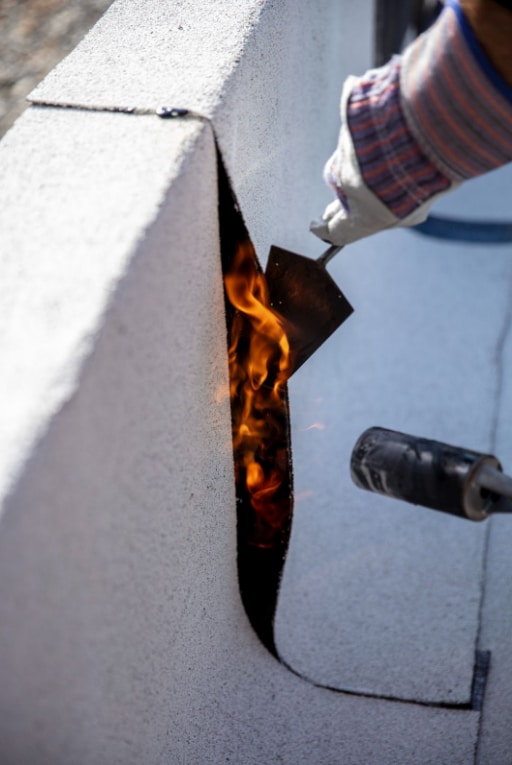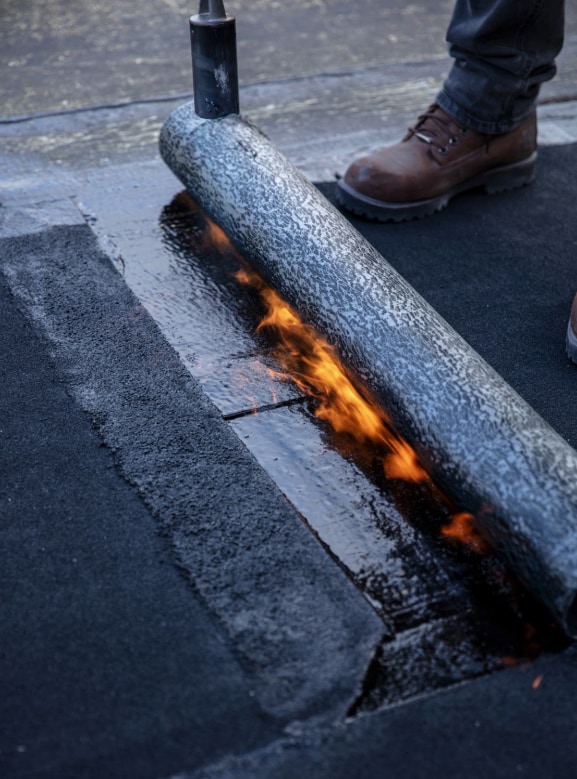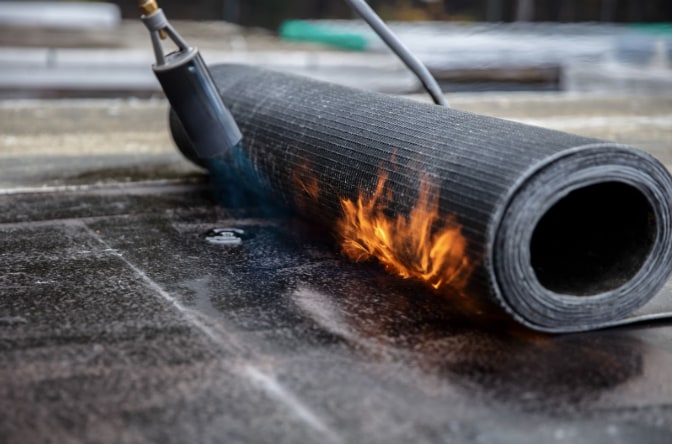As a commercial roofing professional, you're responsible for helping your customers find the best roofing systems for their needs, which means staying in the know about materials and methods. Torch down roofing is a roofing installation process that uses a handheld propane torch to heat up and install sheets of modified bitumen roofing material. As these sheets are laid out, the torch's heat bonds the material to the layer beneath, forming a tight seal that's hard for water to penetrate.
Between this weatherproof seal and the modified bitumen materials' ability to expand and contract without cracking, torch down roofing is a popular choice among building owners everywhere—particularly in areas with extreme weather conditions and for commercial buildings with flat or low-slope roofs. Read on to learn more about this roofing method, including key benefits, installation, materials, costs, and more.
Benefits of Torch Down Roofing
Torch down roofing offers several benefits for commercial roofing projects, including exceptional durability, water resistance, energy efficiency, and longevity.
Durability
Torch down roofing is a durable roof option that can reliably withstand harsh weather conditions like heavy rainfall, snow, and temperature fluctuations. Modified bitumen, the material this method uses, is flexible due to the polymer infused in the bitumen and has excellent waterproofing properties. This bitumen enhancement helps these membranes hold up in weather conditions where other materials would become brittle and crack.
Water Resistance
Torch down roofing's heat-welded application creates a seamless membrane with exceptional water resistance, making it a common choice for flat and low-slope roofs where ponding water is a real concern. The modified bitumen material is mixed with polymers to create an elastic material that resists cracking, further reducing the risk of water infiltration.
To add to its already excellent waterproofing abilities, torch down roofing offers multiple layers of protection. Including one or more base sheets and a granulated cap sheet, this assembly ensures that, if one layer becomes damaged, the others can still protect the substrate below from water infiltration.
Energy Efficiency
Installing a surface layer consisting of a granule cap sheet provides more ultraviolet (UV) resistance, which impacts the roof's energy efficiency. By reflecting UV rays from the roof's surface, the roof absorbs less heat, helping the building interior stay cooler and reducing demand on the HVAC system. The insulation layer within a torch down roofing system also helps regulate building temperature and reduce energy costs for heating and cooling, providing eco-friendly and cost benefits whether it's warm or cold outside. This US resistance can also help defend against building movement of expansion and contraction due to reduction of heat in decking joints and parapet walls where this condition is more commonly observed.

Longevity
Materials like GAF's APP (Atactic Polypropylene) RUBEROID® Torch Membranes are guaranteed for up to 15 to 20 years and have great torch down properties that make them an ideal product for smaller low-slope projects. An even more premium membrane offering is GAF's SBS (Styrene-Butadiene-Styrene) RUBEROID® HW Membranes which can be guaranteed up to 20 or even 30 years. SBS membranes are considered top performance due to their low temperature flexibility and high elongation (elastic) properties in part due to the SBS polymer/bitumen blend. Both of these types of roofing membranes require minimal maintenance after installation and though regular inspections and upkeep can help ensure the roof lasts longer.
Understanding the Torch Down Roofing Installation Process
To safely install a torch down roof, you should have specialized training, such as NRCA's CERTA Train-the-trainer program. With this training under your belt, you can expect to follow these general steps when installing a torch down roof.
Prepare and Insulate the Roof
Prepare the roof's surface by removing dust, grease, dirt, debris, and any old roofing material, and ensure the surface is completely dry. Before you lay down the base and cap sheet layers, a vapor barrier attached to the wood, concrete or steel deck is recommended and often a critical part of the roof design. Insulation would be installed next — securely attached with fasteners or adhered with glue or hot mopping asphalt — to help the building retain heat and improve the roof's energy efficiency. You'll then add the overlay board, or commonly called a coverboard, as the last component, which will act as the substrate you attach the multi-ply torch down roofing system to. This is a complete "typical" roof assembly for a low-slope roof.
Install the Torch Down Roofing System
Attach the base sheet to the overlay board (coverboard) using heat welding, an adhesive, or fasteners. Then, install a granulated cap sheet over the smooth base sheet, wielding the handheld torch carefully to heat the cap sheet rolls as you place them over the base sheet. The layers should adhere tightly and form a waterproof seal. You will see the bitumen melting or softening as heat is applied uniformly to the previously installed base sheet and the new cap membrane. This observation will help ensure your membranes are chemically bonded together.
Before installing a modified bitumen membrane of any type it is required to unroll the roll and allow the membrane to fully relax. This process usually takes around 30 minutes and helps the roll retain its original shape and size since sitting in storage or packaging for extended periods of time. Re roll the roll after the elapsed time has ended and you are ready to install. In the field of the roof, allow at a minimum 2 inches of overlap at the side edges and 6 inches (embedding the bottom layers granules) at end laps to ensure proper adhesion between the layers and ensure a proper water-tight seal. Dont forget to dog ear the bottom membrane corner on the cap (surface) sheet to ensure no backwater laps occur eliminating an area called a T-joint where water is most likely to penetrate the installed system. Finally, install flashing around the roof's edges and vents similarly to the field installation of two or more plies of membrane and proper side lap overlap. You can cut small parts of the roofing membrane and lay them over the flashing to effectively secure it to the roof and create a watertight seal. It is always recommended to reference the technical installation manuals and directions outlined by the manufacturer and reach out to their field technical team if more assistance is needed.
Inspect Your Work
Once installed, inspect the entire area to ensure the flashing covers any vulnerable points and that the new roofing membrane material isn't wrinkled or lifted. If there are any issues, reheat the material as necessary.
Types of Torch Down Roofing Materials
Torch down roofing tends to use two types of modified bitumen: Atactic Polypropylene (APP) and Styrene-Butadiene-Styrene (SBS) as outlined above. These materials are similar, but despite their common characteristics, they have a couple of slight differences. APP is treated with plastic polymers, which gives it a strong, rigid surface and excellent UV resistance. SBS is treated with synthetic rubber, providing it with enhanced flexibility and excellent performance in low-temperature flexibility.
APP modified bitumen membranes can withstand heavy impact and provide great protection against UV rays. Meanwhile, SBS modified bitumen membranes have superior elastic properties, allowing them to expand and contract with minimal risk of cracking or breaking the scrim which acts as a carrier for the modified bitumen. This flexibility is especially useful in areas that experience colder temperatures.
It's not uncommon to install layers made of both materials. Some systems might use SBS modified bitumen as the base layer since it's more flexible and APP modified bitumen as the cap sheet layer since it's more impact- and UV-resistant.
Torch Down Roofing Costs
While the material costs for a torch down roof are relatively inexpensive, the labor costs can significantly increase the overall project price. Using a heated torch requires extra insurance and specialized training and tools, which all factor into the price of installation.
Torch down SBS or APP roofing has an average cost of $3.50 to $7.00 per square foot including materials and installation, which is around the middle of the pack for commercial roofing solutions. It's cheaper than metal roofs but generally more expensive than BUR, TPO and EPDM.
In terms of cost savings, APP modified bitumen roofing is typically slightly cheaper than its SBS counterpart, due to its polymer chemical make-up, so APP is usually the more cost-effective option typically seen on projects with smaller scopes of work. For both SBS and APP assemblies you can select a two-layer system (base & cap sheet) instead of installing a three-layer system, which can speed up the installation process and reduce spending on materials. However, ensure key building decision-makers understand that this can decrease lifespan and reduce UV and waterproofing resistance. Some guarantees may also require a three-layer system so it is wise to check with the technical team at each manufacturer to see what guarantees are available with each assembly.

Maintenance and Repairs
Roofs installed with torch down asphaltic roofing generally require very little maintenance due to the multi-ply redundancy, but routine inspections and care can help them maintain optimal effectiveness and potentially extend their lifespan. Any debris buildup, such as tree branches, leaves or dirt, can affect the roof's drainage system and create standing water, so it's recommended to remove debris at least once a year or based on manufacturers warranty guidelines. If ponding water is observed it is recommended to discuss options with the designer on record or a manufacturers representative as to protect the roofing membranes.
If the roof develops any small cracks or holes along the layers, you can typically patch them up with the same APP or SBS modified bitumen material used during installation.
Environmental Impact of Torch Down Roofing
Torch down roofing has pros and cons when it comes to environmental impact. It promotes good energy efficiency, which can reduce a building's carbon footprint. The system's longevity also helps reduce material waste in the long term by minimizing the need for frequent roof replacements. When it comes to recycling, some of the modified bitumen material can be recycled into other asphalt products. However, some parts end up in landfills. Modified bitumen is also a petroleum product, which isn't considered environmentally friendly. To extend the service life of an asphaltic system a roof coating system using an asphalt bleedblock primer is recommended if the system underneath is dry or there are no unlying issues. This coating can not only prolong your existing warranty but help maintain a watertight roof integrity for years to come.
A Reliable Choice for Flat and Low-Slope Commercial Roofs
Torch down roofing is a popular process for creating a seamless chemical bond among multiple layers of modified bitumen material. Through its heated application, this method results in a durable, water-resistant seal that helps protect buildings located in areas where harsh weather is typical. Overall, torch down roofing is a good choice if you're looking for a cost-effective, long-lasting commercial roofing solution, particularly for flat and low-slope roofs. To learn more about asphaltic membrane installation methods, check out our Asphaltic Commercial Roofing 101 playlist on YouTube.

